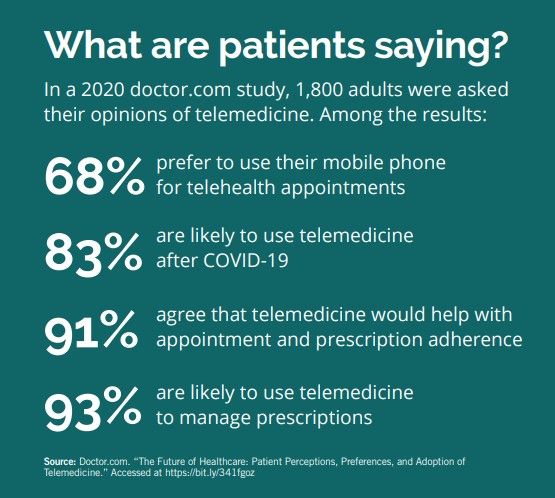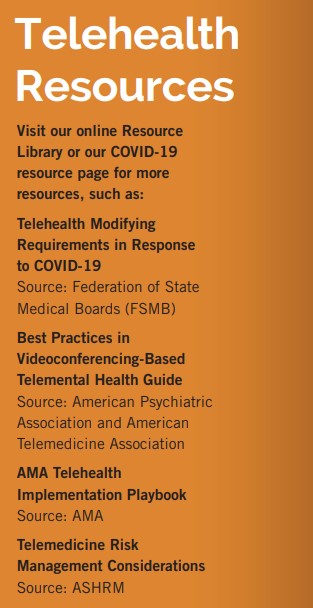While in rural Oregon during his residency in 2014, Dr. Anthony Cheng never guessed that he’d glimpse the future of how medicine would be delivered during a pandemic. But what he experienced during that formative time in his career intrigued him about the possibilities of telehealth.
Those possibilities have been coming to fruition—fast—during the coronavirus crisis, paving the way for lasting and beneficial changes to patient care. There are still big obstacles to the growth of telehealth, and it’s certainly no panacea for every problem. But “we can do more with telehealth than we realize,” Dr. Cheng says.
It was certainly more than he realized six years ago when he started working in a rural hospital emergency room. The nearest neurologist was two hours away, so the department used telehealth to care for stroke patients. That way, a specialist could help with emergency decision-making, which wouldn’t have been possible without technology.
More than 20% of people in Enterprise—the Eastern Oregon town where Dr. Cheng practiced—were 65 and older, so addressing end-of-life issues was a focus for the hospital. So Dr. Cheng created a telehealth program for palliative care to help patients at the end of life. “It proved to me that complex conversations can occur with videoconferencing,” he says. “I had my doubts, but this, along with the medical complexity of acute stroke being managed with telehealth, helped convince me that we can do a lot of primary care this way.” 
And so, Dr. Cheng became an early proponent of telehealth and began pioneering its use. Since then, working with other colleagues, he’s helped transform nine primary-care practices to offer meaningful telehealth options during COVID-19.
PATIENT-CENTERED CARE
Today, Dr. Cheng is a family physician at Oregon Health & Science University’s Primary Care Clinic, South Waterfront, in Portland, Oregon. He is also an Assistant Professor of Family Medicine at OHSU’s School of Medicine. He has a special interest in pediatrics and adolescent health, LGBTQ and transgender care, and medication-assisted treatment for opioid addiction. Pregnancy, mental health, and end-oflife care are also of particular interest to Dr. Cheng.
“I’m passionate about family medicine, because it’s so personal,” he says. “I want to know what makes a patient tick, so I can use this information to optimize their health.”
One might think that treating patients over videoconference is less personal than in-person visits, but according to Dr. Cheng, it’s an opportunity for the physician to enter the patient’s personal space—a virtual house call—which can shift the doctor/patient dynamic in a positive way. Right off the bat, “seeing a patient’s living situation can help with your decision-making,” he says, because it provides insight into their circumstances and any health choices they might be making.
What’s more, it creates a comfort level that is crucial for certain patients, such as those with anxiety or who are gender-nonconforming. For some, going to a doctor’s office is scary because of past negative experiences, and talking with their doctor from home helps them communicate and absorb information better.
Then there’s the convenience factor, which nearly all patients can appreciate. “Patients are less impatient waiting in their living room than in a doctor’s waiting room,” says Dr. Cheng. People with restrictive schedules—such as hourly workers and those caring for elderly parents and children—who may have difficulty accessing care in the office-space model, can also benefit from more widely available telehealth options.
It’s also helpful for those with chronic diseases such as diabetes, who need frequent reassessments that can be burdensome. Providing these patients with medical-care kits at home and teaching them how to check their own vitals can be empowering and encourage them to be more engaged in improving their health.
“Shifting to the home as the center of care promotes the self-efficacy of the patient,” Dr. Cheng says. “It helps patients and providers think about how care plans fit into a patient’s life. It shifts the ownership of their health to them. Telehealth really fits into the patient-centered care model, because telehealth is all centered around them.”
INTERPERSONAL PITFALLS
There are limitations to a virtual visit too, though, so there’s an inherently greater degree of uncertainty in diagnosis. Dr. Cheng makes sure to communicate that to the patient so they understand there is a potential for error, and he incorporates that into his decision-making. Sometimes a problem simply can’t be diagnosed virtually, and the patient has to come in after all. But that doesn’t mean the virtual visit was a waste of time, Dr. Cheng emphasizes. “It gives us a head start on resolving the complaint, and then the second visit can go deeper,” he says.
One often-overlooked telehealth privacy issue that concerns Dr. Cheng is the doctor and patient settings. “Are both in a place where they truly have privacy and no one else can hear?” he says. “I worry about it more on the patient’s end, especially with adolescents. Am I getting the whole story if the patient thinks a parent could overhear the conversation through a closed door?”

DIGITAL DIVIDE
Another problem area for telehealth is widening disparities in tech usage based on age, race, and income level. “There are knowledge gaps and access gaps,” Dr. Cheng says, “but if needs are identified—and that may take time and multiple conversations—we can fill them if resources are built into workflows. We’ve got to normalize the challenges, because folks hesitate to share their difficulties with us.”
One harbinger for the digital divide in health finally being bridged, Dr. Cheng points out, is seeing how it’s been done during the pandemic by schools. “It was so complicated to get technology to students during this crisis for home learning,” he says. “But while challenges remain with online learning, the successes show it’s possible to do the same in health and get technology to all patient populations.”
In the broadest sense, we can’t leave anyone out of the delivery system where telehealth is concerned. “Our standard of work needs to be centered on the margins,” Dr. Cheng says. “It’s easier for us, and might be seen as more efficient, to plan for the majority in our population, but that approach leaves people out and could widen the health disparities that already exist.”
A PANDEMIC PUSH
Telehealth has existed in primary care for a very long time—in the form of nurse triage by phone, for example—but virtual visits weren't widely adopted until about five years ago, when Americans’ use of digital devices like smartphones reached a critical threshold. It wasn’t until the pandemic that many providers started using it, out of necessity.
“While promoting telehealth adoption before COVID, I heard that people didn’t think the change was worth it,” Dr. Cheng says. “They didn’t think patients really wanted it, and they were satisfied with their current practice. So, given the limitations of virtual visits, they were hesitant to fully embrace telehealth.”
The pandemic created a need for telehealth that forced our hand. “It made a lot of people realize telehealth is more powerful than they thought,” Dr. Cheng says.
What the future of telehealth holds depends somewhat on how the economics play out in terms of reimbursement levels once the pandemic is over. Right now, it feels exciting and possible to make telehealth happen in a big way—and as Dr. Cheng points out, “since we want to meet patient needs the best way possible, how we get paid shouldn’t limit that.”
The financial aspect is only the tip of the iceberg, though. Staff need to be re-trained, doctors have to do things differently, and patients need to adjust. “It’s a lot of work, and it puts everyone under stress,” Dr. Cheng says. In his experience, practices could benefit from creating a staff position of “Digital Health Navigator” to re-create workflows and guide everyone through the process.
Ultimately, Dr. Cheng urges practices to adapt—because telehealth is here to stay. “It will be a proportion of our business from now on,” he says. “Patients are going to become more familiar and comfortable with it, and it will become more robust in terms of options. It will bring more of the office to the patient.”